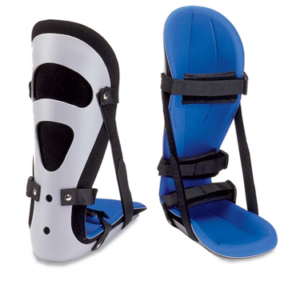Pain in the neck: The need to knows of Cervical/Cervical-Thoracic Orthosis
Have you been in an accident and injured your cervical spine? Have you had corrective surgery in cervical or upper thoracic spine? Here is some information that will help you during your healing process and how to properly wear your doctor prescribed cervical collar or cervical-thoracic orthosis (CTO).
To begin you must understand the cervical spine. The cervical spine has seven vertebrae, it houses and protects the spinal cord, supports the head and its movement, and facilitates flow of blood to the brain. Knowing the key roles that your cervical spine serves, any injury to the neck or cervical spine should warrant an appointment with a physician right away for medical intervention as further damage can be done. Your physician will determine if surgery is required or if the injury will heal on its own. Often, even if surgery is required, a cervical orthosis may be worn after the surgery to stabilize the affected cervical area to allow the surgical site to heal. If surgery is not required, a cervical orthosis may be used to prevent further injury while the area heals on its own. If the injury involves the lower cervical vertebra or upper thoracic vertebra a cervical-thoracic orthosis (CTO) maybe prescribed. A CTO is designed to keep your cervical and upper thoracic spine from flexing and extending. The orthosis works to immobilize the head and upper body with an occipital section in the back and the chin piece in the front which is then anchored to the upper body with a vest for stabilization. The front and back sections are held together with two Velcro straps at your neck, two shoulder straps and two waist straps.
There are several different types and styles of cervical collars and CTOs. Below you find some helpful fitting tips, wearing and caring for your orthosis, and some common problems people have and how to mitigate it.
Soft Collar
Description: Soft collars are less restrictive than rigid collars, and therefore typically used with less severe injuries, where flexion, extension, and rotation should be limited but not necessarily prohibited. The collar is secured by a Velcro strap and is considered more comfortable and easier to take on and off when compared to more rigid devices.
Fitting tips:
To properly apply your collar, look straight ahead and keep your chin parallel to the floor. Fit the collar snugly around your neck with the “dip” in the collar lined up against your chin and attach the Velcro at the back of your neck.
Wearing and Caring: Your referring physician determines the wearing schedule for the brace. Should the collar get soiled, it can be handwashed with mild soap and water and air dried.
Common Problems: Over-tightening the collar may lead to breathing and comfort issues. Ensure the fit is snug but not too tight. Skin breakdown may also occur with persistent wearing, so check the skin daily for any skin irritations.
Semi-Rigid/Rigid Collar
Description: The more rigid collars have a plastic frame and holds your head in a neutral position while preventing flexion, extension, and rotation. The brace will be adjusted to a tight fit to promote stability and should lie evenly around your neck. Typically, these braces come in two parts – a posterior and anterior part and are attached via two Velcro straps on either side.
Fitting tips: The cervical collar should be applied either lying down or with your head in a neutral position, and someone should stabilize your head and neck. Apply the back portion of the collar so it wraps around your neck and cups the back of the head. Apply the front section so it cups under the chin and rests on the upper chest. The front slides inside the back portion and Velcro straps are pulled as tight as tolerated to secure the brace in place. When fastening Velcro straps ensure they are pulled to equal length on either side, this will ensure the brace on straight.
Wearing and Caring: Your referring physician determines the wearing schedule for the brace. Should the collar get soiled, the pads can be removed, handwashed with mild soap and water, and air dried. Extra padding sets are available for purchase if you call our office. You need approval from your doctor to take the collar on and off while sitting up. Follow up with your practitioner if you are experiencing any difficulty with comfort or fit.
Common Problems: Over-tightening the collar may lead to breathing and comfort issues. Ensure the fit is snug but not too tight. Skin breakdown may also occur with persistent wearing, so check the skin daily for any skin irritations. Under-tightening may cause chin slipping issues, where the chin tucks down into the brace. If this occurs, check the tightness, most likely the brace was not fastened tight enough to hold the chin piece in place.
Cervical/Thoracic Orthosis (CTO)
Description: CTO’s are used to treat fractures in the cervical spine (neck) and the upper part of the thoracic spine (upper back). It maintains the head in a neutral position, reduces pain, prevents further injury and promotes healing. The brace will stabilize your cervical and thoracic regions and typically has a cervical collar component attached to a vest that anchors at your waist to prevent rotation. This brace is more restrictive than the cervical collar and provides more stability over a greater area. The CTO consists two pieces, a front and back. The front piece has a plastic mandibular support attached to a chest piece. The back piece has a plastic occipital support attached to a back portion of the vest piece. You will find that there are a couple of different styles of CTO braces, including some prefabricated styles such as Minerva and Aspen. For additional support, or for patients who don’t fit into prefabricated braces, custom CTO braces can also be made for the patient, this will provide a personal fit for that specific to a patient’s measurements.
Fitting tips: The CTO should be applied while lying down with your head in a neutral position. This enables gravity to draw the abdomen and unloads and relaxes the spine. While lying completely flat, log roll onto your side with someone stabilizing your head and neck. The front and back sections are marked respectfully, so apply the back piece so that the cervical extension follows the curve of the head. The bottom edge of the brace should be placed at the waist just above the hips. Make sure the brace is LOW enough on the patient and roll back into the brace. Apply the front half of the brace making sure the bottom edge is placed at the waist, lining up with the back portion. The chin section should be under the chin, cupping the mandible. Clip or Velcro the chin straps to the back headpiece. Clip or Velcro the waist straps and any shoulder straps. Please note the shoulder straps should not be tight on the patient. Fasten forehead strap (if provided).
Wearing and Caring: Wear the brace over a single layer of clothing, such as a T-shirt or undershirt. All other clothes should be worn on the outside of the brace. Be sure to check your skin each day for any red, sore or irritated spots. Your caregiver will need to help you with this. Call your doctor, nurse, or therapist if you see any spots on the skin from the brace that do not go away within 15-20 minutes.
Instructions on how to put on the brace…
1. Log roll onto your side keeping your head, neck, shoulders, and hips in a straight line. Do not bend or turn your neck to the side without the rest of your body turning as a whole.
2. Your caregiver should place the back piece of the collar on the back of your neck, so it is centered.
3. Place the back piece of the brace on the bed with the shoulder and trunk straps spread out behind you.
4. Log roll back onto the back piece of the brace, keeping your head, neck, shoulders, and hips in a straight line while holding the back piece of the cervical collar.
5. Your caregiver should hold the front of the collar and slide it up until it rests under your chin. The sides of the collar front should be off the collar bone, angled toward your ears. The front collar ends are to be inside the back piece of the collar. The lower edge of the front part of the brace should be resting against the rib cage or just below the breasts.
6. Attach the Velcro straps on each side. Tighten side straps so they are equal in length on both sides.
7. Be sure the back part of the brace is in the center of your back.
8. Connect the shoulder straps to attach the front of the brace to the back. Both shoulder straps should be of equal length. These may be loose when you are lying flat. Adjust these straps for a snug fit after you sit up.
9. Buckle rib straps, pulling straps even and tight.
10. Make sure that all straps lie flat with no slack or gaps.
Common Problems Over-tightening the collar may lead to breathing and comfort issues. Ensure the fit is snug but not too tight. Skin breakdown may also occur with persistent wearing, so check the skin daily for any skin irritations. Under-tightening may cause chin slipping issues, where the chin tucks down into the brace. If this occurs, check the tightness, most likely the brace was not fastened tight enough to hold the chin piece in place.
The CTO is designed to protect your spine, you will not be able to bend or twist in it. The CTO will not allow a forward slouch of the head and shoulders and may feel uncomfortable if you try to do so. These devices require patience, as they are not comfortable and may need several adjustments. These devices tend to ride up on the body towards the head over time. This is unavoidable and the device will require repositioning from time to time.
When you are fit with one of these braces, you should not hesitate to ask your medical provider any questions you have. Just remember, knowledge is power!





